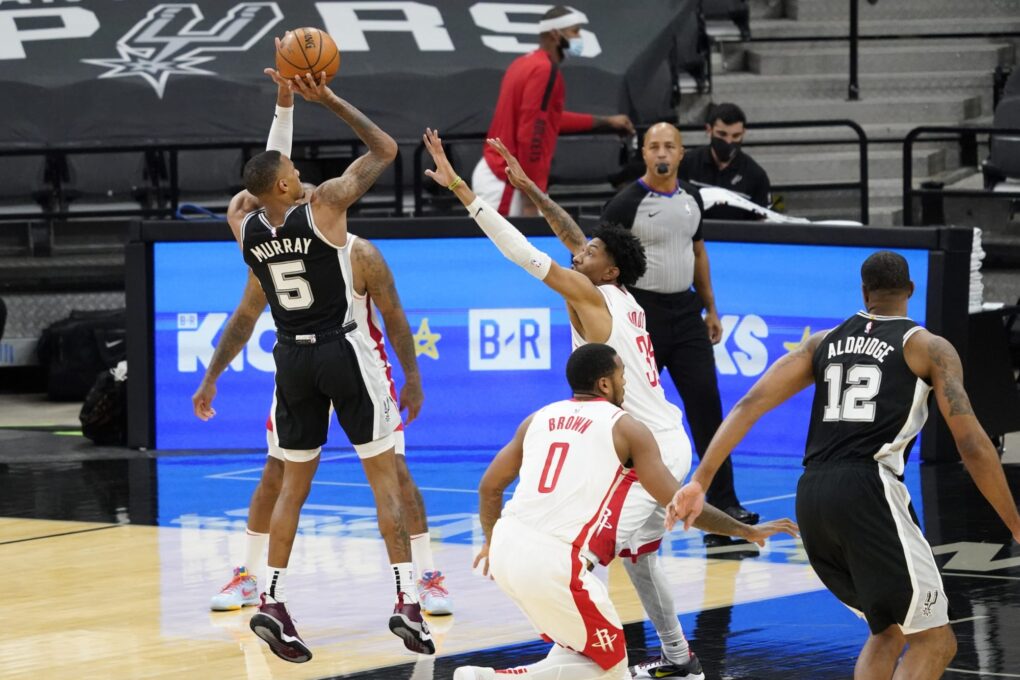San Antonio Spurs: Shot quality is improving with more 3-pointers

By increasing their 3-point volume in the 2020-21 regular season, the San Antonio Spurs are improving their bread and butter: The mid-range jumper.
No team has stayed true to the mid-range jumper like the San Antonio Spurs have during the NBA’s 3-point renaissance of the modern era. Year after year, they rank amongst the top of the league in mid-range field goal attempts and percentage with LaMarcus Aldridge and DeMar DeRozan at the helm.
Times have changed, and teams are more cognizant of a basketball court’s geography than ever. San Antonio’s former vice president for strategic research, Kirk Goldsberry, wrote the bible of shot-tracking entitled ‘Sprawlball’ in 2019. Maybe Spurs patriarch Gregg Popovich gave it a read during the offseason because the San Antonio Spurs are buying into the trend in a unique fashion.
San Antonio’s 3-point volume has obviously increased this season, and their offense is flourishing because of it. With designated shooters Marco Belinelli and Bryn Forbes off the team, everyone’s chipping in by increasing their 3-point volume. Six Spurs players are taking at least 3.2 triples per contest, including Aldridge and DeRozan, who are taking more threes within the flow of the offense.
How taking more threes helps the San Antonio Spurs in other ways
By spreading the floor with more 3-point attempts and better spacing, the quality of mid-range jumpers improves. Better spacing allows the Spurs’ up-and-comers to get better shots in that range too. Over time, starting point guard Dejounte Murray has become a fine mid-range shooter with a knack for breaking defenders down with a dribble and creating separation for jumpers.
San Antonio is also capitalizing on this newfound appreciation for the 3-point line by picking up their pace of play. The Spurs’ offensive system is best when the ball is zipping around the court with decisiveness as it did in the 2014 NBA season. Their up-tempo style dominated the NBA then, and this core has the tools necessary to execute in a similar setting.
San Antonio is leading the league in field goal attempts per game (94.7) and ranks 11th in pace after finishing 14th a year ago. Their young players are shooting with more confidence, propelling them to a top spot in above-the-break 3-point percentage at 37.5. Before DeMar DeRozan’s brief absence and a rough stretch against Minnesota, OKC, and Houston, the Spurs ranked No. 1 in this category. They’ll have a chance to climb back as DeRozan gets his feet under him again.
This improved space allows the Spurs’ array of jump shooters to use the mid-range to exploit their gravity. Knowing that San Antonio is a mid-range-heavy team factors into the way opposing teams defend them. Opponents are more likely to emphasize mid-range defense against the Spurs than they might be against a more 3-point heavy team like Houston or Milwaukee.
Defenses collapse more often when the Spurs use that mid-range space, which opens the floor up for more open 3-pointers, drives to the basket, and easy points off cuts.
The Spurs are averaging more drives per game this year than they did a year ago. They’re passing out of the drive at a similar rate, but they’re getting more ball handlers involved than a year ago. DeRozan’s usage rate is down 2.4 percent, while Lonnie Walker and Keldon Johnson have both seen rapid upticks in their usage.
More from Air Alamo
This should be taken with a grain of salt as Derrick White’s absence leaves more touches to go around, but the team’s mentality is shifting nonetheless.
These last few games aren’t anything to write home about. Losing to the depleted versions of Minnesota and Houston was less than ideal, and scrapping for that most recent victory over the Rockets left room for improvement.
When you have a team that’s played a certain way for multiple seasons, it’s hard to break old habits. As games come down to the wire, DeRozan is more likely to go into takeover mode for better or worse. Their 3-point emphasis slows down, and the Spurs rely on isolation plays to get the job done.
However, there are clear signs of hope. Dejounte’s confidence and decision-making in clutch situations continuously improve. Walker’s 3-ball is falling at a tremendous rate, and his finishing near the rim is dramatically improving. Aldridge’s points are mostly coming off of assists as his teammates learn to facilitate the offense and honor their vet’s abilities.
Is this the perfect situation for the Spurs? Absolutely not, but they’re learning to play a modernized version of the game, and their young pieces are getting better as part of it.
















